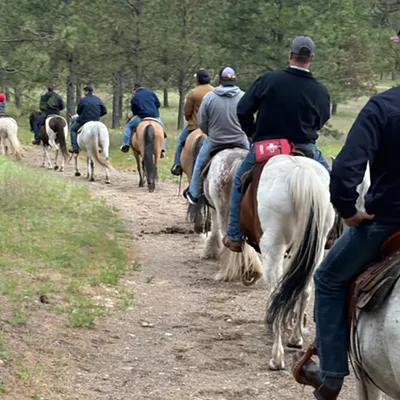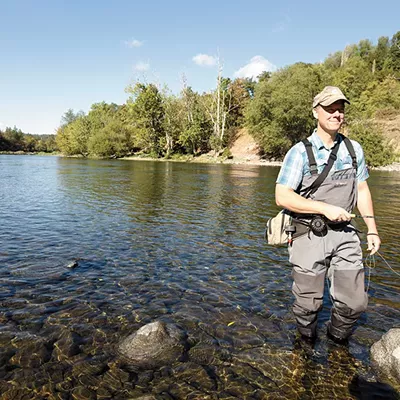From smoking salmon to roasting venison, eating nature is fun. But it's not nearly as fun when nature turns right around and tries to eat you.
Fortunately, statistically, wild animal attacks are generally rare. You're much more likely to die from a deer running in front of your car than, say, a bear or wolf attacking you.
Here's a general rule: Unless you're between an animal and its kid, animals prefer to avoid humans altogether. Big animals don't like surprises. So, generally, the best way to avoid being attacked by animals when walking through the woods is to act like a stereotypical American on vacation — talk loudly and stomp around like you own the place.
BEARS
Generally, preventing an attack can sometimes be as simple as proving your humanity by standing tall, waving your arms slowly and speaking to it calmly. Don't scream or make sudden movements.
Otherwise? Bear spray, bear spray, bear spray. Bear spray was what saved Inlander freelancer Bob Legasa after a grizzly chomped through a bone in his arm last year. Though, in the chaos, it wasn't his bear spray that saved him — he ended up spraying himself — but rather his hunting partner who managed to use bear spray to force the bear to retreat. In other words, hike in groups, and practice using bear spray (ideally with a training can) before trusting your aim.
"There's a lot of people who do some harm to themselves by not knowing how to use bear spray," says Staci Lehman, spokeswoman for the Washington Department of Fish and Wildlife.
An article in Outside magazine also says that other useful tools can include marine flares and, in very well-trained hands, a pistol. But in any case, don't run. Bears are faster. And don't think you can climb a tree. Black bears can climb after you, and with grizzly bears, you won't have time to climb. If you're actually attacked, lay on your stomach in the fetal position and protect your neck.
COUGARS
Cougar attacks remain rare, with less than two dozen recorded attacks in Washington state in the past century. But one of those attacks was just last year when a cougar attacked two mountain bikers, killing one. The Washington Department of Fish and Wildlife gives a few pieces of advice. Back away slowly while trying to appear larger than normal. If it looks like it's about to attack, yell, wave your arms and even chuck your water bottle at it. Show the cougar you are the danger. Don't run. That's the quickest way to become fast food.
And then if it attacks, fight back with whatever you have. Sticks. Stones. Your backpack. And bear spray works on cougars, too.
"You can use bear spray on anything," Lehman says.
WOLVES
Let's get one thing straight right off the bat: Wolves may loom as terrors in the popular imagination, but they rarely attack people. Only two confirmed deaths have come at the jaws of healthy wild wolves in North American in the last 100 years.
"Any wild animal can potentially be dangerous to people," says Julia Smith, wolf coordinator for the Washington Department of Fish and Wildlife. "In general wolves pose very little danger."
If a wolf is acting aggressive, chances are that you're in the den area, Lehman says. It might be best to turn around and leave, but slowly.
"Act casual," Lehman says.
But the rare cases are scary ones. A vivid 2014 account of one of those rare wolf attack cases in Outside magazine featured the account of teenager being randomly attacked by a wolf while sleeping outside in Minnesota. The 16-year-old literally pulled the wolves jaws away from his head, then started kicking and screaming at it.
And that, a Minnesota Department of Natural Resources manager told Outside magazine, was exactly the right thing to do. Don't run away. Don't act like prey. Go Liam Neeson on 'em.
"Running away may have further triggered the predator's natural reaction to attack," he said.
MOOSE
Sure, moose are all likeable and friendly when they're taking down Communists with their squirrel buddies or leaving tracks in your ice cream. But real moose are actually one of the more dangerous animals in the wild.
The Alaska Department of Fish and Game rattles off a few instances when the generally peaceful moose might get violent. If they feel harassed, irritated, hungry or tired. If it's a bull moose during mating season in September and October. If you get between them and their child. Or if you have a dog. Moose hate dogs. They don't understand the nuances between an adorable Australian shepherd and a vicious gray wolf.
If the ears tilt back and the hair on its hump goes up, the moose may be about to charge, and that's your cue to duck behind a tree. Moose are one of the rare animals where running away can actually work. They often won't chase you very far and, best of all, you can actually outrun them simply by running around and around a tree, Benny Hill-style. Bear spray can work on a charging moose, too.
If you do get hit and knocked over, go fetal, protect your head, and wait until the moose gets bored and leaves before getting back up.
OTTERS
Local animal attack victim Megan Sherwin still has the scars. Two decades ago, she was in Rockford Bay on Lake Coeur d'Alene when they suddenly heard a bump.
"My friend yelled, 'It's a gopher thing!'" Sherwin says, describing her horror as an otter climbed into their canoe. They freaked out, the canoe tipped over, and as she fled for the shore, she says, the otter latched onto her back.
"I had scars — scratches or bites — on my arms, my wrists and my back," Sherwin says. She was rushed to a hospital, she says, where she had to get rabies shots. The scariest thing? To this day, the otter has never been found.
Lehman says Fish and Wildlife doesn't often get questions about vicious otters.
"It would be like anything else," Lehman says. "Like being attacked by a house cat. Try to avoid its teeth and get it off of you as fast as you can."
TURKEYS
Time was, turkeys feared man. But lately, as any resident on Spokane's South Hill knows, turkeys are getting more and more aggressive toward us at the top of the food chain.
Wayne Petersen, with the Massachusetts Audubon Society, told PBS's Nova last year that the key is to reassert your dominance.
"You shouldn't back away from the turkey or look like you're afraid of them," Petersen says. "Stand your ground, flap your arms and run at it. They can be generally intimidated without too much problem."
Avoid the sharp spurs on the back of their feet, Lehman says. Spray them with a hose if necessary. Remember, you eat turkeys like him for dinner. Typically with cranberry sauce.
And the same advice works on attacks from that other infamously aggressive waterfowl, geese. Don't be intimidated. You're bigger than the goose.
"Kick a goose if you have to," Lehman says. ♦





















